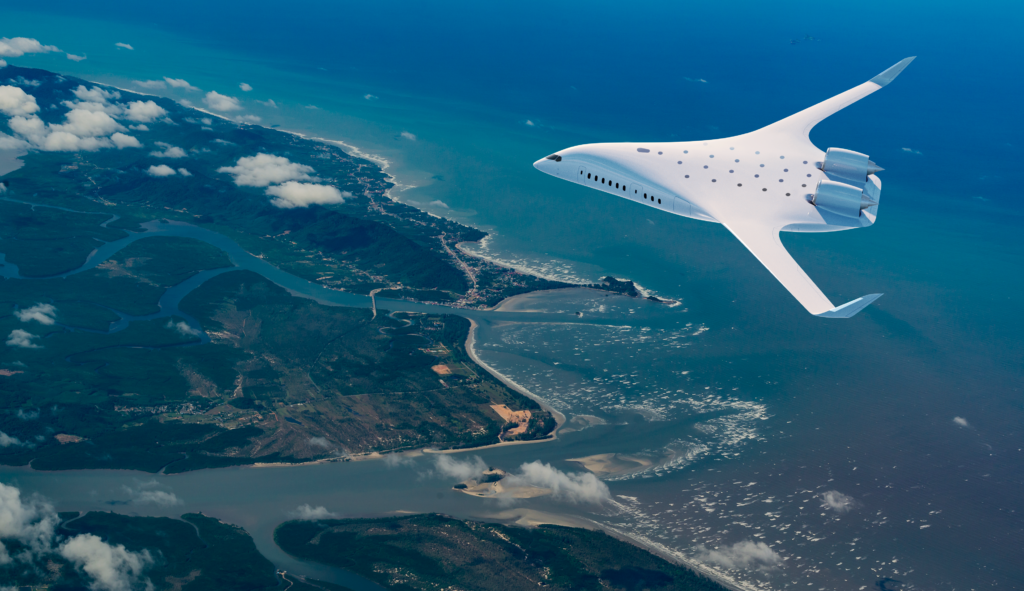JetZero’s Blended-Wing Aircraft Gains Momentum with Major Airline and U.S. Government Support
Share
JetZero, a pioneering aerospace startup based in California, made significant strides this week with its innovative blended-wing body aircraft, which promises to reduce fuel consumption by up to 50% compared to traditional tube-and-wing aircraft. The aircraft uses existing next-generation single-aisle aircraft engines and can fly as far as trans-oceanic. Alaska Airlines’ investment this week marked the first direct airline backing for JetZero, signaling a strong vote of confidence in the technology’s potential to transform the future of air travel.

”The new JetZero aircraft experience will be publicly unveiled for airlines at APEX Global EXPO, showcasing the blended-wing-design transformative potential in air travel.” – APEX Group CEO Dr. Joe Leader.
Beyond fuel efficiency, JetZero’s blended-wing body aircraft aims to deliver a radically different passenger experience. With a wider, more spacious cabin, the design offers the potential for new configurations that could redefine comfort and functionality in air travel. This approach targets the environmental benefits and seeks to enhance the overall passenger journey, marking a significant shift from conventional aircraft designs.
Strategic Industry Unveiling at APEX Global EXPO
The aviation industry eagerly anticipates the public unveiling of JetZero’s aircraft on the evening of Sunday, October 27, just before the APEX Global EXPO in Long Beach. APEX Group CEO Dr. Joe Leader emphasized the importance of this event, stating, “The new JetZero aircraft experience will be publicly unveiled for airlines at APEX Global EXPO, showcasing the blended-wing-design transformative potential in air travel.” According to Aviation Week, the innovative design offers substantial fuel savings. It enhances passenger comfort and cargo capacity, positioning the aircraft as a strong contender for commercial and military applications.
Alaska Airlines Makes First Airline Backing
Alaska Airlines’ investment in JetZero is closely aligned with the airline’s ambitious sustainability goals. The airline has a clear strategy to achieve net-zero carbon emissions by 2040, and this investment represents a critical step towards that objective. Diana Birkett Rakow, Senior Vice President of Public Affairs and Sustainability at Alaska Airlines, stated, ”We are proud to invest in JetZero’s development of this innovative next-generation aircraft, with a significant step-change in fuel efficiency. We and JetZero share a vision for more sustainable aviation, and we are excited to partner with them in creating that future.”
“We are proud to invest in JetZero’s development of this innovative next-generation aircraft, with a significant step-change in fuel efficiency. We and JetZero share a vision for more sustainable aviation, and we are excited to partner with them in creating that future.” – Diana Birkett Rakow, Senior Vice President of Public Affairs and Sustainability at Alaska Airlines.
Following Alaska Airlines’ investment in JetZero, ch-aviation news suggested that the innovative blended-wing body aircraft could serve as a critical asset in the airline’s planned merger with Hawaiian Airlines. This merger seeks to enhance the combined network across the Pacific, expanding destination offerings and improving service options for travelers. With the potential to cut fuel consumption by up to 50%, the JetZero aircraft could optimize long-haul routes between the U.S. mainland and Hawaii, aligning with Alaska Airlines’ vision for greater efficiency and sustainability after the merger. As the merger advances, integrating advanced technology like JetZero’s aircraft could unlock significant operational synergies, allowing the combined airline to maintain a competitive edge in an increasingly consolidated industry.
Challenges and Criticism
However, despite the optimism surrounding JetZero, the company faces significant challenges. The development of such a novel aircraft requires overcoming considerable financial and logistical hurdles. According to New Atlas, the competitive landscape raises questions about how JetZero plans to scale production and bring its aircraft to market by the ambitious 2030 target. JetZero counters that utilizing existing aircraft engines in a more efficient manner leapfrogs one of the most significant hurdles facing new aircraft manufacturers: requiring new engines. The U.S. government’s backing for the first aircraft also enables a source of capital certainty.
”The interior layout and passenger comfort in such a large, unconventional cabin present a significant challenge.” – Professor Werner Granzeier in Aircraft Interiors International Magazine
Other critics have also pointed out potential issues with the aircraft’s design. The blended-wing body’s wider wingspan might limit compatibility with existing airport infrastructure, and the unique interior layout could complicate passenger evacuation procedures. Additionally, some experts fear passengers seated near the edges of the aircraft might experience uncomfortable motion due to the increased distance from the roll axis during turns. “The interior layout and passenger comfort in such a large, unconventional cabin present a significant challenge,” noted Professor Werner Granzeier in Aircraft Interiors International Magazine. By unveiling the onboard airline passenger experience at APEX Global EXPO, JetZero plans to assertively address these concerns with verified ready-for-market solutions.
An Airline Path Forward to 50% Fuel Savings
Despite any challenges, JetZero’s partnership with the U.S. Department of the Air Force and its innovative approach to aviation could pave the way for a more sustainable future in the skies. The company’s upcoming public unveiling at the APEX Global EXPO in Long Beach will be a critical step forward for the airline industry, offering the aviation industry a closer look at what could be the next major evolution in aircraft design with fuel savings of up to 50% over current aircraft.


